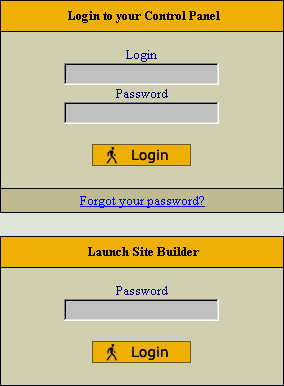|
This document covers the following topics:
Your Temporary Index Page
You will be able to access your Web site right after you
register your account. To do this, you will have to use an
instant domain alias . Instant Domain Alias is an additional
web address which lets you access your site during the first
several hours after the domain name registration, the time
when the site is yet unavailable at the newly registered domain.
Over the next few days DNS servers all across the Internet
will update themselves with your new site name. Once that
happens, you will be able to access your site at the domain
you have registered.
The moment your account is registered, a temporary index
page is added to your site's directory. It will look like
this:

It will be there until you upload your site and replace
it with your own index page (e.g. yoursite/index.html).
Meanwhile, from this temporary page you can:
- administer your account. Enter your control panel login
and password into "Login to your Control Panel".
This login and password are e-mailed to you at the address
you specified at signup. Use the Control Panel to view your
bills, change your contact/billing information, change passwords,
get more disk space, report problems to the technical support
staff and much, much more.
- create a web site in a matter of minutes right from your
browser. Use the option "Launch Site Builder".
Initially, the password to log into the site builder is
the same as that for the control panel.
Uploading Your Site
You have two alternative ways to upload your site to the
server:
- Using PC based FTP agents, such as CuteFTP or SmartFTP;
- Using the built-in web-based FTP agent. (See WebShell for details).
Important: Don't upload your site to the root of your
user directory! See below for the explanation.
Contents of Your Home Directory
Your home directory contains several default subdirectories.
Their number and names will differ depending on your plan,
yet some of them are common for all plans. Here are
some of the directories that are automatically created and
may not be deleted:
- Directories that contain your sites. Each of your
sites is put in a separate directory. The name of the
directory is the same as your site's domain name.
If you have more than one site, you will have several such
directories. These are the directories where you will upload
your .html files or any other files that you want to make
accessible from the Internet. Each of these directories
may contain their own /webalizer or /modlogan directories.
Do not delete either of these directories!
Your site is too valuable to lose at a touch of a button.
- The Logs directory. It contains directories for
every site with transfer log enabled. Each such directory
contains its own set of log files that are required to write
and read the data about all visits to your sites.
Deleting the Logs directory will cause the loss of the web statistics
accumulated in the course of your site operation.
Click here for
more on web statistics.
- The Virtual FTP directory. Its name is the dedicated
IP address. This directory is created when you enable Virtual
FTP Server and can be accessed by virtual FTP users to list
and download its content. There are as many such directories
as dedicated IP addresses. Deleting Virtual FTP directories will
cause incorrect operation of Virtual FTP. However,
you may harmlessly delete individual files in these directories.
Click here for more on Virtual FTP.
- The subdomain directories. When you make a subdomain,
a new directory is created with the subdomain
name as the directory name. If you delete a subdomain
directory, internet visitors will get the 404 "File not found"
error when attempting to access the subdomain.
Click here
to read on how to create subdomains.
- The ssl.conf directory. This directory stores SSL pairs
for all encrypted sites. Deleting the ssl.conf directory
will result in incorrect SSL operation.
Warning: Don't delete ANY default directories in your
root directory, as this will cause malfunctions of your acount.
As a rule of thumb, you may delete only directories and files
you have uploaded yourselves or that have been uploaded by
any of your Virtual FTP and Anonymous FTP users.
|